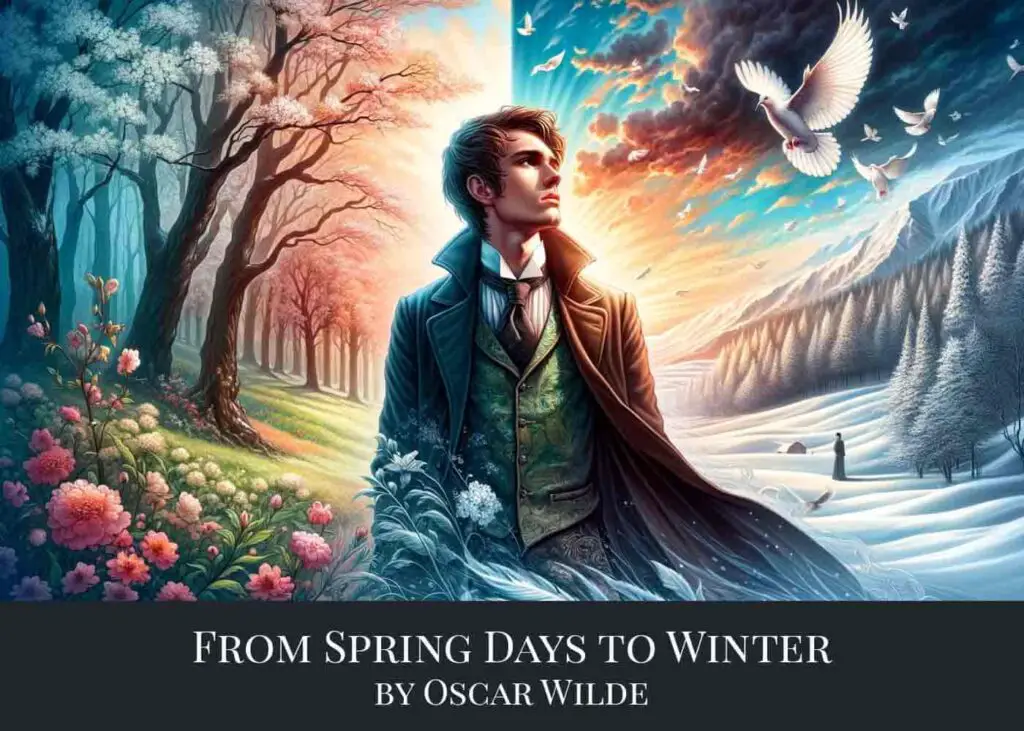
From Spring Days to Winter by Oscar Wilde
“From Spring Days to Winter” is a poignant poem by playwright and poet Oscar Wilde, featured in his first poetry volume Poems. This piece masterfully encapsulates the ephemeral nature of love and the inevitable passage of time, using the changing seasons as a metaphor for the life cycle of a romantic relationship. “From Spring Days to Winter” traverses the emotional landscape from the joyous bloom of love in spring to its melancholic end in winter. Wilde uses vivid imagery and the recurring motif of a singing throstle (a type of songbird) to illustrate the changing seasons and the corresponding stages of love.
Readers interested in exploring the breadth of Wilde’s poetic expression can find a diverse collection of his poems in Poems ebook available at PageVio.
1. The Poem
In the glad springtime when leaves were green,
O merrily the throstle sings!
I sought, amid the tangled sheen,
Love whom mine eyes had never seen,
O the glad dove has golden wings!
Between the blossoms red and white,
O merrily the throstle sings!
My love first came into my sight,
O perfect vision of delight,
O the glad dove has golden wings!
The yellow apples glowed like fire,
O merrily the throstle sings!
O Love too great for lip or lyre,
Blown rose of love and of desire,
O the glad dove has golden wings!
But now with snow the tree is grey,
Ah, sadly now the throstle sings!
My love is dead: ah! well-a-day,
See at her silent feet I lay
A dove with broken wings!
Ah, Love! ah, Love! that thou wert slain—
Fond Dove, fond Dove return again!
Download From Spring Days to Winter Poster
Size: 8″ x 12″ (2:3 ratio)
Format: PDF
Copyright information: For personal use only
Note: Actual poster background color is white. For the sample poster, the background is made gray for illustration purpose.
2. From Spring Days to Winter Analysis
“From Spring Days to Winter,” structured with repeating refrains, narrates a story of love found and then lost, set against the backdrop of the changing seasons, which symbolize the stages of a romantic relationship.
The first three stanzas are filled with joy and vitality, reflecting the onset of love in the “glad springtime.” The green leaves and the merry song of the throstle (a songbird, likely a thrush) set a scene of youthful and vibrant nature. The speaker speaks of seeking and then finding Love, a person whom he had never seen before. This encounter happens amid the blossoms, symbolizing the blossoming of his love. The refrain “O the glad dove has golden wings” in each stanza adds a note of happiness and beauty, suggesting the precious and delightful nature of new love.
In the third stanza, the imagery of “yellow apples glowed like fire” continues the theme of vibrant, passionate love. The speaker describes his emotions as overwhelming and beyond expression (“too great for lip or lyre”), likening Love to a “blown rose of love and of desire,” which indicates the full bloom, beauty, and intensity of his feelings.
However, the tone shifts dramatically in the final stanza. The tree is now grey with snow, indicating winter, which symbolizes the end of the relationship. The throstle’s song turns sad, reflecting the speaker’s sorrow. The speaker laments the death of his love (“My love is dead: ah! well-a-day”), and the imagery of a dove with broken wings contrasts sharply with the earlier stanzas’ golden-winged dove, symbolizing the end of joy and the arrival of grief and loss.
The final lines, “Ah, Love! ah, Love! that thou wert slain— Fond Dove, fond Dove return again!” express the speaker’s deep sorrow and longing for the return of the love that is now lost. The poem as a whole captures the full arc of a romantic relationship, from its joyful beginning to its sorrowful end, using the changing seasons and the natural imagery of birds and trees as metaphors for the stages of love.
3. Conclusion
Oscar Wilde’s “From Spring Days to Winter” is sure to evoke deep emotions within you. Embark on a poetic journey with our list of Oscar Wilde’s poems.